From Policy to Practice: EU Circular Economy Legislation and Slovenia’s Implementation Challenges—A Systematic Review
Abstract
1. Introduction
2. Literature Review
2.1. Circular Economy and the European Commission Policies
2.2. Slovenia, a Small Market for Business and Waste
2.3. Conceptual Foundations and Previous Studies
3. Methods and Analysis
4. Results
4.1. Monitoring Frameworks and Slovenia’s Indicator Performance
4.2. Waste Consideration
4.3. CE Indicators on Waste: A Slovenian Case
4.3.1. Institutional Framework and Policy Alignment
- Education and inclusion of various stakeholders in the transition to CE to break the link between economic growth and growth in consumption of resources and GHG emissions.
- Promotion of innovation, the use of design and information, and communication technologies to develop new business models and products that use raw materials and energy more efficiently [68];
- Replacement of fossil fuels with the promotion of EE and the use of RES in all areas of energy use.
- Ensuring that infrastructure and energy use in transport support the transition to low-carbon CE
- Using spatial planning to design nodes for the low-carbon CE [44].
- Material productivity, i.e., the ratio between GDP and total domestic material consumption
- Share of Renewable Energy in Gross Final Energy Consumption
- GDP per Total GHG emissions: set the goal to be the EU average in 2030
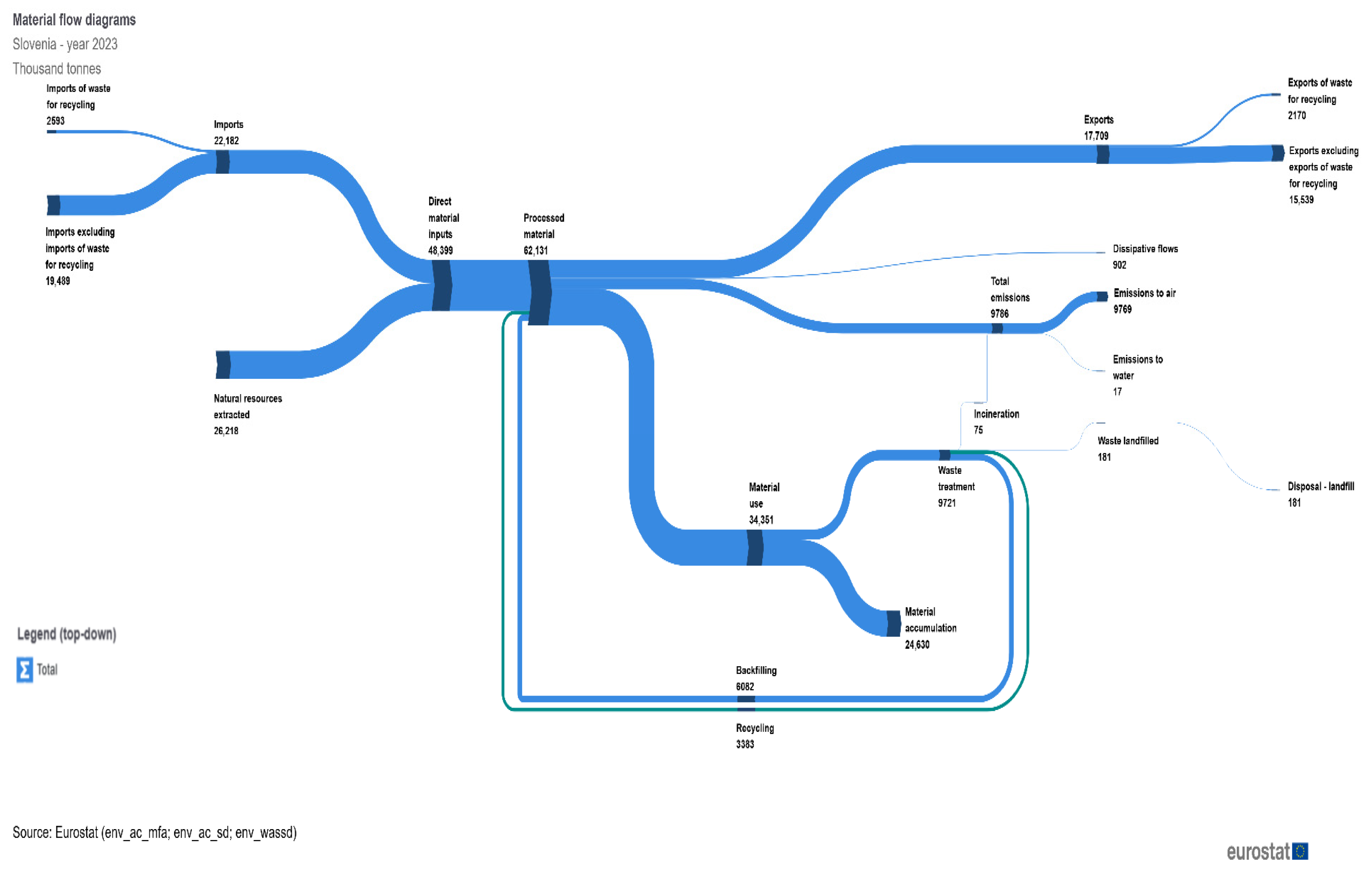
4.3.2. Quantitative Indicators and Performance Data
4.3.3. Emerging Challenges and Sectoral Insights
5. Discussion
6. Conclusions, Implications and Future Work
Supplementary Materials
Author Contributions
Funding
Institutional Review Board Statement
Informed Consent Statement
Data Availability Statement
Conflicts of Interest
Abbreviations
| EE | Energy Efficiency (appears in the Slovenian Development Strategy section) |
| EC | European Commission |
| COM | Commission document (e.g., COM(2018) 29) |
| ARSO | Agencija Republike Slovenije za okolje (Slovenian Environment Agency) |
| CE | Circular Economy |
| CMU | Circular Material Use (rate) |
| DMC | Domestic Material Consumption |
| EEA | European Environment Agency |
| EU | European Union |
| GDP | Gross Domestic Product |
| GHG | Greenhouse Gas |
| HEIs | Higher Education Institutions |
| IRB | Institutional Review Board |
| NECP | National Energy and Climate Plan |
| NGO | Non-Governmental Organization |
| NWPP | National Waste Prevention Program |
| OECD | Organization for Economic Co-operation and Development |
| PPP | Purchasing Power Parity |
| PRISMA | Preferred Reporting Items for Systematic Reviews and Meta-Analyses |
| RES | Renewable Energy Sources |
| RRP | Recovery and Resilience Plan |
| SDGs | Sustainable Development Goals |
| SME(s) | Small and Medium-Sized Enterprise(s) |
| WFD | Waste Framework Directive (Directive (EU) 2018/851 amending Directive 2008/98/EC) |
| PPWD | Packaging and Packaging Waste Directive (Directive (EU) 2018/852 amending Directive 94/62/EC) |
| MWR | Municipal Waste Recycling rate (indicator, %) |
| MWG | Municipal Waste Generation (indicator, kg per capita) |
| PWR | Packaging Waste Recycling rate (indicator, %) |
| PPR | Plastic Packaging Recycling rate (indicator, %) |
| LFR | Landfilling Rate of municipal waste (indicator, %) |
| SRT | Secondary Raw Material Trade (indicator, tons, €) |
| RP | Resource Productivity (GDP/DMC; indicator, EUR/kg) |
References
- Ellen MacArthur Foundation Circular Economy Introduction. Available online: https://www.ellenmacarthurfoundation.org/topics/circular-economy-introduction/overview (accessed on 24 September 2025).
- European Commission Circular Economy—European Commission. Available online: https://environment.ec.europa.eu/topics/circular-economy_en (accessed on 24 September 2025).
- Ottomano Palmisano, G.; Rocchi, L.; Negri, L.; Piscitelli, L. Evaluating the Progress of the EU Countries Towards Implementation of the European Green Deal: A Multiple Criteria Approach. Land 2025, 14, 141. [Google Scholar] [CrossRef]
- European Commision Better Regulation. Available online: https://commission.europa.eu/law/law-making-process/better-regulation_en (accessed on 19 August 2025).
- Abujder Ochoa, W.A.; Torrico Arce, A.G.; Iarozinski Neto, A.; Munaro, M.R.; Calabokis, O.P.; Ballesteros-Ballesteros, V.A. Interlinking Urban Sustainability, Circular Economy and Complexity: A Systematic Literature Review. Sustainability 2025, 17, 7118. [Google Scholar] [CrossRef]
- Kurrer, C. Environment Policy: General Principles and Basic Framework. Available online: https://www.europarl.europa.eu/factsheets/en/sheet/71/environment-policy-general-principles-and-basic-framework (accessed on 29 June 2022).
- Huang, L.-T.; Villari, B. Co-Creation in Circular Cities: A Design Perspective. DISCERN Int. J. Des. Soc. Change Sustain. Innov. Entrep. 2021, 2, 69–88. [Google Scholar]
- European Commission. Communication from the Commission to the European Parliament, the Council, the European Economic and Social Committee and the Committee of the Regions A European Strategy for Plastics in a Circular Economy; European Union: Brussels, Belgium, 2018. [Google Scholar]
- Schmidt, J.; Grau, L.; Auer, M.; Maletz, R.; Woidasky, J. Multilayer Packaging in a Circular Economy. Polymers 2022, 14, 1825. [Google Scholar] [CrossRef]
- Kondo, R.; Kinoshita, Y.; Yamada, T. Green Procurement Decisions with Carbon Leakage by Global Suppliers and Order Quantities under Different Carbon Tax. Sustainability 2019, 11, 3710. [Google Scholar] [CrossRef]
- Toia, P. Circular Economy Action Plan: Achieving Plan’s Ambitious Goals Means Investing in Research and Innovation. Available online: https://www.theparliamentmagazine.eu/news/article/innovating-through-circularity (accessed on 19 August 2025).
- Ellen MacArthur Foundation MacArthur, Ellen Foundation. An Economic and Business Rationale for an Accelerated Transition. Available online: https://ellenmacarthurfoundation.org/towards-the-circular-economy-vol-1-an-economic-and-business-rationale-for-an (accessed on 18 July 2022).
- European Commission. Report from the Commission to the European Parliament, the Council, the European Economic and Social Committee and the Committee of the Regions on the Implementation of the Circular Economy Action Plan; European Union: Brussels, Belgium, 2019. [Google Scholar]
- European Commission. A New Circular Economy Action Plan for a Cleaner and More Competitive Europe—COM/2020/98; European Union: Brussels, Belgium, 2020. [Google Scholar]
- Broughton, A.; Mohamedaly, A.; Bourneix, J.; Weber, C.; Cioanca, A.; Parchomenko, A. Literature Review on a Measurable Definition of Green Jobs and on the Impact on Jobs and Skills in the Green Transition; European Union: Brussels, Belgium, 2024. [Google Scholar]
- Stanef-Puică, M.-R.; Badea, L.; Șerban-Oprescu, G.-L.; Șerban-Oprescu, A.-T.; Frâncu, L.-G.; Crețu, A. Green Jobs—A Literature Review. Int. J. Environ. Res. Public Health 2022, 19, 7998. [Google Scholar] [CrossRef]
- Lommerse, I.; Loots, E. Entrepreneurial Practices in Eco-Innovation: Circular Challenges Related to the Tomato Textile Project in the Netherlands. In Entrepreneurship as Practice: Time for More Managerial Relevance; Ratten, V., Ed.; Springer Nature: Singapore, 2022; pp. 57–76. ISBN 978-981-19-4819-0. [Google Scholar]
- Kaur, B.J.; Kulshreshtha, H. Circular Economy Approach: Economy, Livelihoods, and Environment. In STG Policy Papers Policy Brief Circular Economy Approach—Economy, Livelihoods, and Environment; School of Transnational Governance: Firenze, Italy, 2023. [Google Scholar]
- European Commission Circular Economy Action Plan. Available online: https://op.europa.eu/en/publication-detail/-/publication/9dc6aa01-39d2-11eb-b27b-01aa75ed71a1/language-en (accessed on 3 July 2022).
- Republic of Slovenia Slovenia Maintains Its Competitiveness—Standing Out in International Trade and Quality of Life|GOV.SI. Available online: https://www.gov.si/en/news/2025-06-17-slovenia-maintains-its-competitiveness-standing-out-in-international-trade-and-quality-of-life/ (accessed on 19 August 2025).
- Malinauskaite, J.; Jouhara, H.; Ahmad, L.; Milani, M.; Montorsi, L.; Venturelli, M. Energy Efficiency in Industry: EU and National Policies in Italy and the UK. Energy 2019, 172, 255–269. [Google Scholar] [CrossRef]
- Eurostat Europe 2020 Indicators—Climate Change and Energy. Available online: https://ec.europa.eu/eurostat/statistics-explained/index.php?title=Europe_2020_indicators_-_climate_change_and_energy (accessed on 15 July 2025).
- Slovenia’s Smart Specialisation Strategy—Evropska Sredstva. Available online: https://evropskasredstva.si/en/slovenias-cohesion-policy-programme-2021-2027/slovenias-smart-specialisation-strategy/ (accessed on 10 July 2024).
- European Commission. Communication from the Commission to the European Parliament, the Council, the European Economic and Social Committee, the Committee of the Regions and the European Investment Bank Clean Energy For All Europeans COM/2016/0860 Final; European Union: Brussels, Belgium, 2016. [Google Scholar]
- European Commission. Communication from the Commission to the European Parliament, the Council, the European Economic and Social Committee and the Committee of the Regions Closing the Loop—An EU Action Plan for the Circular Economy; European Union: Brussels, Belgium, 2015. [Google Scholar]
- The European Parliament; The Council of the European Union. Directive (EU) 2018/2002 of the European Parliament and of the Council of 11 December 2018 Amending Directive 2012/27/EU on Energy Efficiency. Off. J. Eur. Union 2018, 328, 210–230. [Google Scholar]
- Canale, L.; Battaglia, V.; Ficco, G.; Puglisi, G.; Dell’Isola, M. Dynamic Evaluation of Heat Thefts Due to Different Thermal Performances and Operations between Adjacent Dwellings. Appl. Sci. 2020, 10, 2436. [Google Scholar] [CrossRef]
- Cholewa, M.; Minh, L.H.B. PLM Solutions in the Process of Supporting the Implementation and Maintenance of the Circular Economy Concept in Manufacturing Companies. Sustainability 2021, 13, 10589. [Google Scholar] [CrossRef]
- Husgafvel, R.; Linkosalmi, L.; Sakaguchi, D.; Hughes, M. Chapter 14—How to Advance Sustainable and Circular Economy-Oriented Public Procurement—A Review of the Operational Environment and a Case Study from the Kymenlaakso Region in Finland. In Circular Economy and Sustainability; Stefanakis, A., Nikolaou, I., Eds.; Elsevier: Amsterdam, The Netherlands, 2022; pp. 227–277. ISBN 978-0-12-819817-9. [Google Scholar]
- Alhawari, O.; Awan, U.; Bhutta, M.K.S.; Ülkü, M.A. Insights from Circular Economy Literature: A Review of Extant Definitions and Unravelling Paths to Future Research. Sustainability 2021, 13, 859. [Google Scholar] [CrossRef]
- Eurostat Circular Economy Monitoring Framework. Available online: https://ec.europa.eu/eurostat/web/circular-economy/monitoring-framework (accessed on 8 April 2024).
- Eurostat. Trade in Recyclable Raw Materials; Eurostat: Luxembourg City, Luxembourg, 2024. [Google Scholar]
- Carvalho, C.; Silva, C.J.; Abreu, M.J. Circular Economy: Literature Review on the Implementation of the Digital Product Passport (DPP) in the Textile Industry. Sustainability 2025, 17, 1802. [Google Scholar] [CrossRef]
- European Commission Commission Seeks Feedback on the Guidelines on Protection of Minors Online under the Digital Services Act|Shaping Europe’s Digital Future. Available online: https://digital-strategy.ec.europa.eu/en/library/commission-seeks-feedback-guidelines-protection-minors-online-under-digital-services-act (accessed on 19 August 2025).
- Eurostat. Circular Material Use Rate; Eurostat: Luxembourg City, Luxembourg, 2024. [Google Scholar]
- European Commission. Clean Planet for All. A European Strategic Long-Term Vision for a Prosperous, Modern, Competitive and Climate Neutral Economy; COM/2018/773 Final; European Union: Brussels, Belgium, 2018. [Google Scholar]
- Skjott Linneberg, M.; Korsgaard, S. Coding Qualitative Data: A Synthesis Guiding the Novice. Qual. Res. J. 2019, 19, 259–270. [Google Scholar] [CrossRef]
- European Commission After the New Normal: Scenarios for Europe in the Post COVID-19 World. Available online: https://op.europa.eu/en/web/eu-law-and-publications/publication-detail/-/publication/fcb24683-b3bf-11ec-9d96-01aa75ed71a1 (accessed on 3 July 2022).
- Page, M.J.; McKenzie, J.E.; Bossuyt, P.M.; Boutron, I.; Hoffmann, T.C.; Mulrow, C.D.; Shamseer, L.; Tetzlaff, J.M.; Akl, E.A.; Brennan, S.E.; et al. The PRISMA 2020 Statement: An Updated Guideline for Reporting Systematic Reviews. BMJ 2021, 372, n71. [Google Scholar] [CrossRef]
- Uršič, E.D.; Fric, U.; Rončević, B. The Circular Economy: Recent Debates and Research Trends. J. Infrastruct. Policy Dev. 2024, 8, 2855. [Google Scholar]
- Cheung, K.K.C.; Tai, K.W.H. The Use of Intercoder Reliability in Qualitative Interview Data Analysis in Science Education. Res. Sci. Technol. Educ. 2023, 41, 1155–1175. [Google Scholar] [CrossRef]
- Proposal for a Uniform Document on the Potentials and Opportunities for the Transition to a Circular Economy in Slovenia. Available online: https://www.circularchange.com/projects-1/2018/11/8/roadmap-towards-the-circular-economy-in-slovenia?rq=Roadmap%20towards%20the%20Circular%20Economy%20in%20Slovenia (accessed on 1 April 2024).
- The Roadmap towards the Circular Economy in Slovenia. Available online: https://circulareconomy.europa.eu/platform/sites/default/files/roadmap_towards_the_circular_economy_in_slovenia.pdf (accessed on 18 September 2025).
- Office for Development and European Cohesion Policy. Slovenian Development Strategy 2030; Government Office for Development and European Cohesion Policy: Ljubljana, Slovenia, 2017. Available online: https://www.gov.si/assets/ministrstva/MKRR/Strategija-razvoja-Slovenije-2030/Slovenian-Development-Strategy-2030.pdf (accessed on 5 August 2025).
- Eurostat Share of Renewable Energy in Gross Final Energy Consumption by Sector. Available online: https://ec.europa.eu/eurostat/databrowser/view/sdg_07_40/default/table?lang=en&category=t_nrg.t_nrg_sdg_07 (accessed on 23 September 2025).
- European Union Database—Eurostat. Available online: https://ec.europa.eu/eurostat/data/database (accessed on 21 December 2023).
- Eurostat Circular Economy Flow Diagrams. Available online: https://ec.europa.eu/eurostat/cache/sankey/circular_economy/sankey.html (accessed on 1 August 2025).
- Eurostat Resource Productivity Statistics. Available online: https://ec.europa.eu/eurostat/statistics-explained/index.php?title=Resource_productivity_statistics (accessed on 23 September 2025).
- Eurostat Overview—Circular Economy—Eurostat. Available online: https://ec.europa.eu/eurostat/web/circular-economy/overview (accessed on 23 September 2025).
- Eurostat Improved Circular Economy Monitoring Framework Now Live. Available online: https://ec.europa.eu/eurostat/web/products-eurostat-news/w/wdn-20230515-1 (accessed on 24 September 2025).
- Kirchherr, J.; Reike, D.; Hekkert, M. Conceptualizing the Circular Economy: An Analysis of 114 Definitions. Resour. Conserv. Recycl. 2017, 127, 221–232. [Google Scholar] [CrossRef]
- Ghisellini, P.; Cialani, C.; Ulgiati, S. A Review on Circular Economy: The Expected Transition to a Balanced Interplay of Environmental and Economic Systems. J. Clean. Prod. 2016, 114, 11–32. [Google Scholar] [CrossRef]
- Republic of Slovenia Resolucija o Nacionalnem Programu Varstva Okolja Za Obdobje 2020–2030 (ReNPVO20-30) (PISRS)LO1985 NPB0 2020. Available online: https://pisrs.si/pregledPredpisa?id=ODLO1985 (accessed on 20 August 2025).
- European Commission. Measuring Progress Towards Circular Economy in the European Union—Key Indicators for a Monitoring Framework. Accompanying the Document Communication from the Commission to the European Parliament, the Council, the European Economic and Social Committee and the Committee of the Regions on a Monitoring Framework for the Circular Economy {COM(2018) 29 Final}; European Union: Brussels, Belgium, 2018. [Google Scholar]
- Lavtizar, V.; Igor, K.; Ladeja, G.K.; Mojca, B.K.; Polonca, T. A Transition Towards the Circular Economy in Slovenia. In Circular Economy: Recent Trends in Global Perspective; Ghosh, S.K., Ghosh, S.K., Eds.; Springer Nature: Singapore, 2021; pp. 425–456. ISBN 978-981-16-0913-8. [Google Scholar]
- ARSO Emissions Productivity|Okoljski Kazalci. Available online: https://kazalci.arso.gov.si/sl/content/emisijska-produktivnost-3 (accessed on 30 August 2024).
- European Commission. Measuring Progress Towards Circular Economy in the European Union—Key Indicators for a Revised Monitoring Framework. Accompanying the Document. Communication from the Commission to the European Parliament, the Council, the European Economic and Social Committee and the Committee of the Regions on a Revised Monitoring Framework for the Circular Economy {COM(2023) 306 final}; European Union: Brussels, Belgium, 2023. [Google Scholar]
- Topliceanu, L.; Puiu, P.G.; Drob, C.; Topliceanu, V.V. Analysis Regarding the Implementation of the Circular Economy in Romania. Sustainability 2023, 15, 333. [Google Scholar] [CrossRef]
- European Parliament. Decision (EU) 2022/591 of the European Parliament and of the Council of 6 April 2022 on a General Union Environment Action Programme to 2030; European Union: Brussels, Belgium, 2022. [Google Scholar]
- Alonso-Almeida, M.d.M.; Rodríguez-Antón, J.M. The Role of Institutional Engagement at the Macro Level in Pushing the Circular Economy in Spain and Its Regions. Int. J. Environ. Res. Public Health 2020, 17, 2086. [Google Scholar] [CrossRef]
- Bonafé, S. Towards a Circular Industrial Strategy—The European Files. Available online: https://www.europeanfiles.eu/climate/towards-a-circular-industrial-strategy (accessed on 19 August 2025).
- Feiferytė-Skirienė, A.; Stasiškienė, Ž. Seeking Circularity: Circular Urban Metabolism in the Context of Industrial Symbiosis. Sustainability 2021, 13, 9094. [Google Scholar] [CrossRef]
- Lee, J.E.; Lee, D.; Lee, J.; Park, Y.-K. Current Methods for Plastic Waste Recycling: Challenges and Opportunities. Chemosphere 2025, 370, 143978. [Google Scholar] [CrossRef]
- European Commission. Proposal for a Regulation of The European Parliament and of The Council on Packaging and Packaging Waste, Amending Regulation (EU) 2019/1020 and Directive (EU) 2019/904, and Repealing Directive 94/62/EC. COM(2022) 677 Final 2022/0396(COD); European Union: Brussels, Belgium, 2022. [Google Scholar]
- European Commission Proposal Packaging and Packaging Waste—European Commission. Available online: https://environment.ec.europa.eu/publications/proposal-packaging-and-packaging-waste_en (accessed on 8 April 2024).
- Fras, Z.; Jug, B.; Jakše, B.; Kreft, S.; Mikec, N.; Malek, Ž.; Bavec, M.; Vovk, A.; Frelih-Larsen, A.; Fidler Mis, N. Slovenia’s Food-Based Dietary Guidelines 2024: Eating for Health and the Planet. Foods 2024, 13, 3026. [Google Scholar] [CrossRef]
- Švarc, J.; Dabić, M.; Lažnjak, J. Assessment of the European Monitoring Frameworks for Circular Economy: The Case of Croatia. Manag. Environ. Qual. Int. J. 2021, 33, 371–389. [Google Scholar] [CrossRef]
- Barbu, M.C.; Tudor, E.M. State of the Art of the Chinese Forestry, Wood Industry and Its Markets. Wood Mater. Sci. Eng. 2022, 17, 1030–1039. [Google Scholar] [CrossRef]
- Velenturf, A.P.M.; Purnell, P. Principles for a Sustainable Circular Economy. Sustain. Prod. Consum. 2021, 27, 1437–1457. [Google Scholar] [CrossRef]
- Smol, M. Inventory and Comparison of Performance Indicators in Circular Economy Roadmaps of the European Countries. Circ. Econ. Sustain. 2023, 3, 557–584. [Google Scholar] [CrossRef]
- Mayer, A.; Haas, W.; Wiedenhofer, D.; Krausmann, F.; Nuss, P.; Blengini, G.A. Measuring Progress towards a Circular Economy: A Monitoring Framework for Economy-Wide Material Loop Closing in the EU28. J. Ind. Ecol. 2019, 23, 62–76. [Google Scholar] [CrossRef]
- European Commission Register of Commission Documents—SWD(2025)324. Available online: https://ec.europa.eu/transparency/documents-register/detail?ref=SWD(2025)324&lang=en (accessed on 23 September 2025).
- Giucă, A.-D.; Rodino, S. Comparative analysis of circular economy indicators across European countries. Curr. Trends Nat. Sci. 2024, 13, 141–152. [Google Scholar] [CrossRef]
- Waste Prevention Country Profile with a Focus on Municipal and Packaging Waste Slovenia. Available online: https://www.eea.europa.eu/en/topics/in-depth/waste-and-recycling/municipal-and-packaging-waste-management-country-profiles-2025/si-municipal-waste-factsheet.pdf/@@download/file (accessed on 22 September 2025).
- Moschen-Schimek, J.; Kasper, T.; Huber-Humer, M. Critical Review of the Recovery Rates of Construction and Demolition Waste in the European Union—An Analysis of Influencing Factors in Selected EU Countries. Waste Manag. 2023, 167, 150–164. [Google Scholar] [CrossRef]
- Aver, B.; Alfirević, N.; Fošner, A. Municipal Waste Recycling Customer Education and Communication in Slovenia and Croatia. Recycling 2023, 8, 45. [Google Scholar] [CrossRef]
- European Commission. Report from the Commission to the European Parliament, the Council, the European Economic and Social Committee and the Committee of the Regions Identifying Member States at Risk of Not Meeting the 2025 Preparing for Re-Use and Recycling Target for Municipal Waste, the 2025 Recycling Target for Packaging Waste and the 2035 Municipal Waste Landfilling Reduction Target. COM(2023) 304 Final; European Union: Brussels, Belgium, 2023. [Google Scholar]
- SURS Food Waste. 2023. Available online: https://www.stat.si/StatWeb/en/news/Index/13128 (accessed on 23 September 2025).
- ITC. Innovation Technology Cluster Fighting Food Waste in Slovenia: Insights, Solutions, and Opportunities. Available online: https://itc-cluster.com/wp-content/uploads/2025/06/FLW_Slovenia_Booklet.pdf (accessed on 3 August 2025).
- Ministry of Agriculture, Forestry and Food. Slovenian National Strategy for Less Food Losses and Food Waste in the Food Supply Chain 2021; Ministry of Agriculture, Forestry and Food: Ljubljana, Slovenia, 2021. Available online: https://www.gov.si/assets/ministrstva/MKGP/PODROCJA/HRANA/Zavrzki_odpadna_hrana/Strategija_Spostujmo-hrano_spostujmo-planet.pdf (accessed on 3 August 2025).
- Drofenik, J.; Urbancl, D.; Goričanec, D.; Kravanja, Z.; Novak Pintarič, Z. Food Waste to Energy through Innovative Coupling of CHP and Heat Pump. Energies 2023, 16, 3344. [Google Scholar] [CrossRef]
- Scrioșteanu, A.; Criveanu, M.M. Reverse Logistics of Packaging Waste under the Conditions of a Sustainable Circular Economy at the Level of the European Union States. Sustainability 2023, 15, 14727. [Google Scholar] [CrossRef]
- Early Warning Assessment Related to the 2025 Targets for Municipal Waste and Packaging Waste: Slovenia. Available online: https://www.eea.europa.eu/en/analysis/publications/many-eu-member-states/early-warning-assessment-related-to-the-2025-targets-for-municipal-waste-and-packaging-waste (accessed on 20 September 2025).
- Soares, C.T.d.M.; Ek, M.; Östmark, E.; Gällstedt, M.; Karlsson, S. Recycling of Multi-Material Multilayer Plastic Packaging: Current Trends and Future Scenarios. Resour. Conserv. Recycl. 2022, 176, 105905. [Google Scholar] [CrossRef]
- Korhonen, J.; Honkasalo, A.; Seppälä, J. Circular Economy: The Concept and Its Limitations. Ecol. Econ. 2018, 143, 37–46. [Google Scholar] [CrossRef]
- Justinek, G. Strategic Integration of Sustainability, Circular Economy, and Blockchain in Slovenian Urban Governance. LeXonomica 2025, 17, 38–58. [Google Scholar] [CrossRef]
- European Environment Agency. Circular Economy in Europe—Developing the Knowledge Base; European Environment Agency: Copenhagen, Denmark, 2016. [Google Scholar]
- European Environment Agency. SIovenia 2024 Circular Economy Country Profile; European Environment Agency: Copenhagen, Denmark, 2024. [Google Scholar]
- Climate KIC. Pioneering Slovenia’s Transformation: A Blueprint for Advancing Circular Economy; Climate KIC: Amsterdam, The Netherlands, 2023. [Google Scholar]
- European Environment Agency. Overview of National Waste Prevention Programmes in Europe: Country Profile: Slovenia; European Environment Agency: Copenhagen, Denmark, 2021. [Google Scholar]
- Pinyol Alberich, J.; Pansera, M.; Hartley, S. Understanding the EU’s Circular Economy Policies through Futures of Circularity. J. Clean. Prod. 2023, 385, 135723. [Google Scholar] [CrossRef]
- Murray, A.; Skene, K.; Haynes, K. The Circular Economy: An Interdisciplinary Exploration of the Concept and Application in a Global Context. J. Bus. Ethics 2017, 140, 369–380. [Google Scholar] [CrossRef]
- Zahra, Z.; Habib, Z.; Hyun, S.; Sajid, M. Nanowaste: Another Future Waste, Its Sources, Release Mechanism, and Removal Strategies in the Environment. Sustainability 2022, 14, 2041. [Google Scholar] [CrossRef]
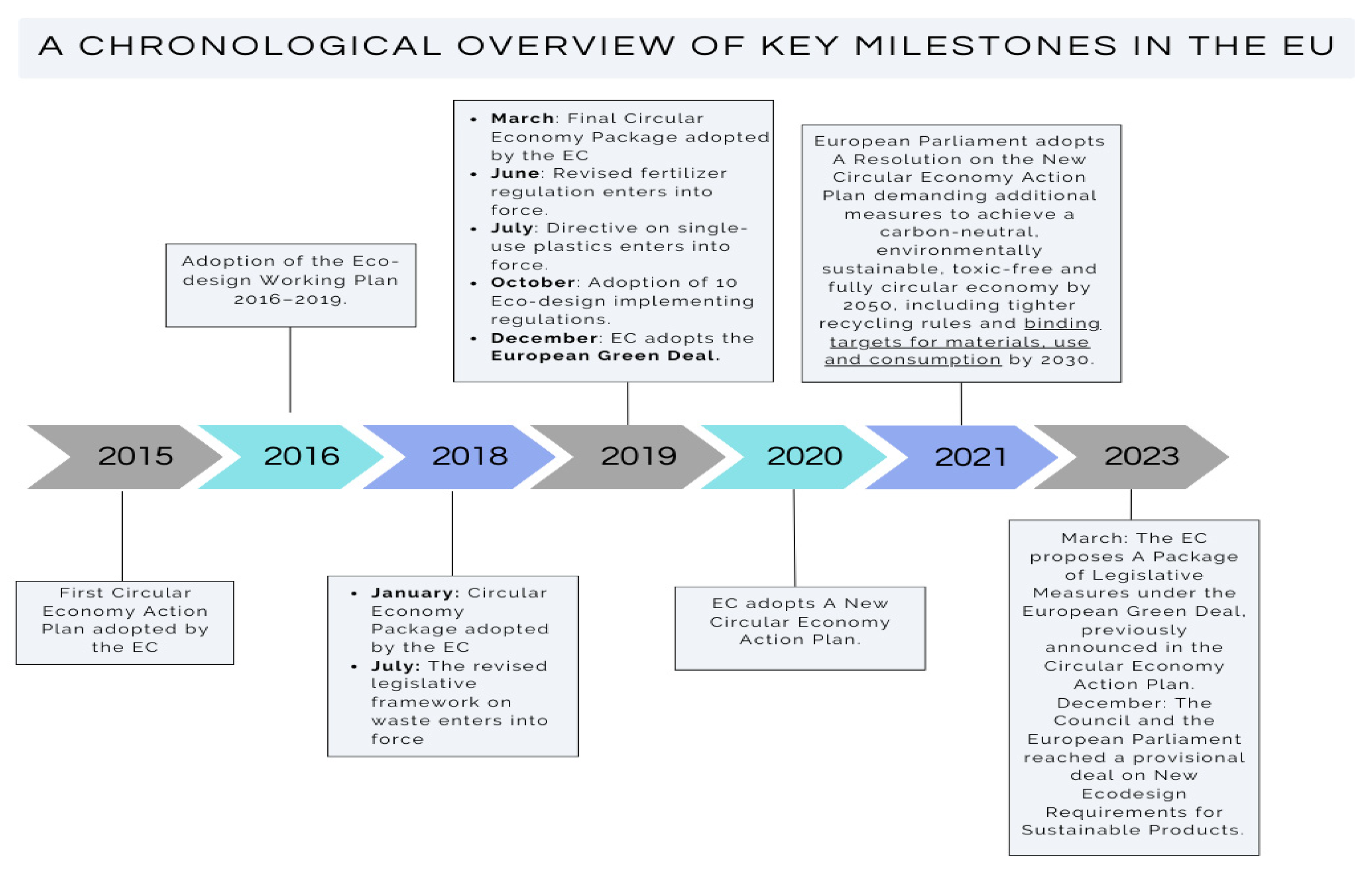
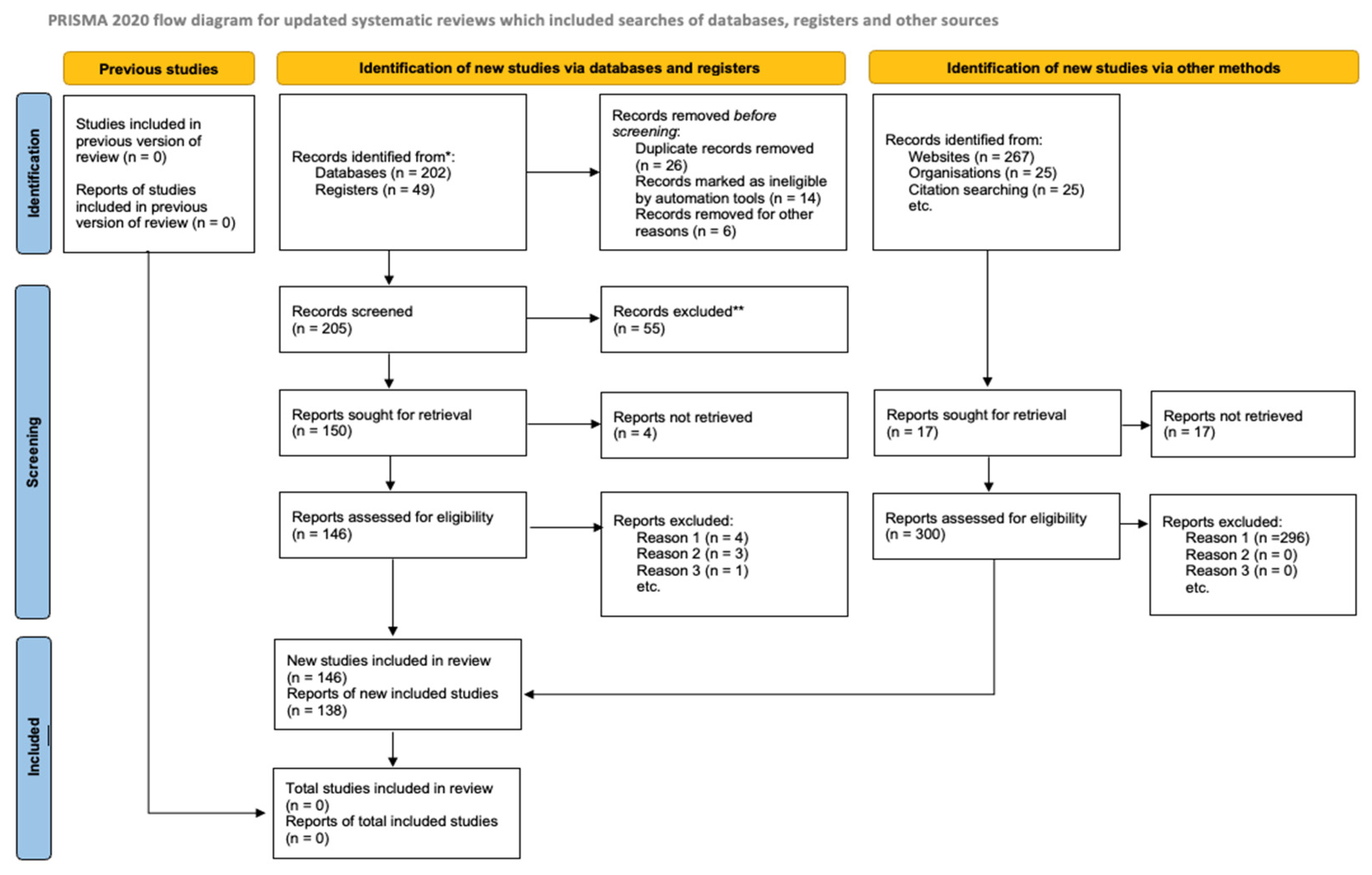
| Author/Year | Country/Context | Type of Study/Document | Focus | Key Findings |
|---|---|---|---|---|
| European Commission [14,25] | EU | Policy framework/Action Plans | EU Circular Economy Action Plans (2015, 2020) | Set the strategic direction for CE at the EU level, introducing the CE Monitoring Framework and emphasizing waste, recycling, resource efficiency, and the use of secondary raw materials. |
| Republic of Slovenia [42,43] | Slovenia | National strategy/Roadmap | Roadmap Towards the Circular Economy in Slovenia | Defined Slovenia’s CE priorities; aligned with EU objectives; emphasized waste reduction, eco-innovation, and stakeholder involvement. |
| Government of Slovenia [44] | Slovenia | National strategy | Slovenia’s Development Strategy 2030 | Integrated CE into long-term development; linked to SDGs; focused on green growth and sustainable consumption/production. |
| Eurostat [22,31,32,35,45,46,47,48,49,50] | EU/Slovenia | Statistical dataset | CE Monitoring Indicators | Provided harmonized indicators (CMU, DMC, recycling rates); Slovenia performs well on recycling, poorly on CMU. |
| Kirchherr et al. [51] | EU/global | Academic survey | CE definitions and perceptions | Found a lack of unified CE definition; mismatch between academic, policy, and business understandings. |
| Ghisellini et al. [52] | Global | Systematic review | Global CE strategies and practices | Synthesized CE practices worldwide; underlined governance challenges and need for policy coherence. |
| Stanef-Puică et al. [16], Broughton et al. [15] | EU | Literature review | Employment, skills and green jobs in CE | Showed potential for green jobs, skills … identified need for reskilling and vocational training. |
| OECD [53] | OECD/EU | Institutional analysis | CE and resource productivity | Compared countries; emphasized monitoring frameworks and productivity indicators. |
| Indicator | Set 2030 Value | Latest Data for 2023 | Source |
|---|---|---|---|
| Material productivity | 3.5 kg PPP/kg | 3.2 PPP/kg (EU 3.9 PPP/kg) | [53,55] |
| Share of Renewable Energy in Gross Final Energy Consumption | 27% | 25.1% (EU 24.6%) | [44,45] |
| Emissions productivity (GDP per Total GHG emissions) | EU average in 2030 | 3.81 (EU 4.11) EURO2010 PPS/kg CO2 latest data for 2021 | [44,56] |
| Monitoring Framework CE Waste Indicators | SI (EU Average) | Year | Trend in the Years 2014 to the Latest Data (See Column Year) |
|---|---|---|---|
| Material consumption | |||
| Material Footprint (tons per capita) | 14.5 (14.1) | 2024 |  |
| Resource productivity (index 2000 = 100) | 199.4 (152.2) | 2024 | 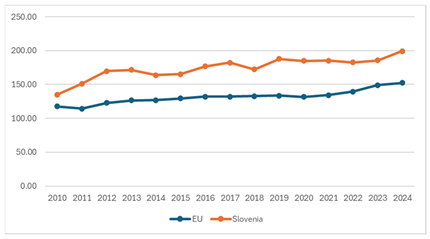 |
| Waste generation | |||
| Total waste generation per capita (kg per capita) | 5398 (4984) | 2022 |  |
| Generation of municipal waste per capita (kg per capita) | 517 (511) | 2023 | 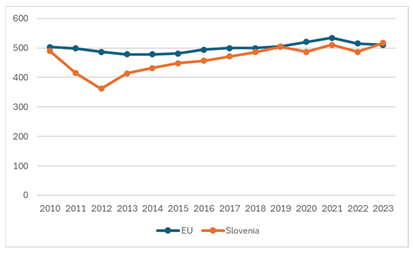 |
| Generation of packaging waste per capita (kg per capita) | 138.5 (178.1) | 2023 | 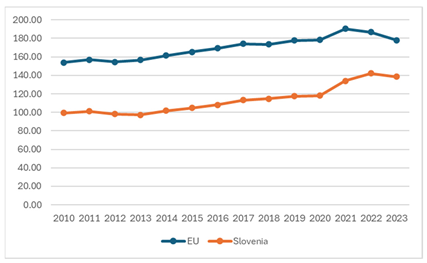 |
| Overall recycling rate | |||
| Recycling rate of municipal waste [%] | 59.8 (48.2) | 2021 | 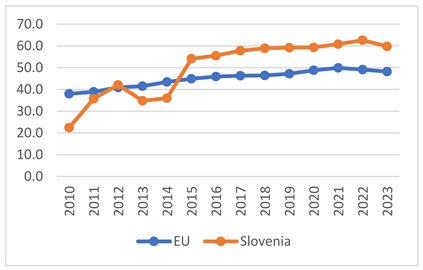 |
| Recycling rate for specific waste streams | |||
| Recycling rate of overall packaging [%] | 73.6 (67) | 2023 | 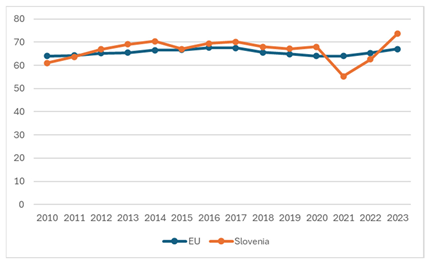 |
| Recycling rate of paper and cardboard packaging [%] | 86.6 (82.2) | 2023 | 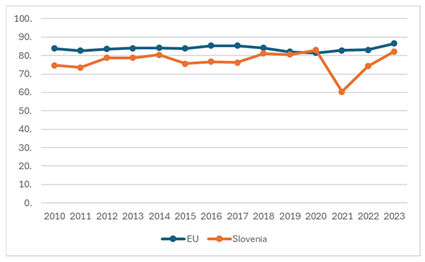 |
| Recycling rate of plastic packaging [%] | 51.5 (41.5) | 2023 | 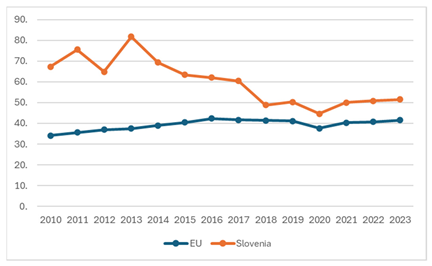 |
| Recycling rate of wooden packaging [%] | 40.0 (36.6) | 2021 | 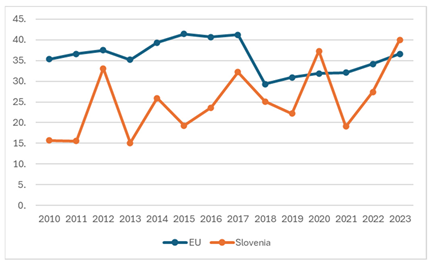 |
| Recycling rate of metallic packaging [%] | 77.9 (100.7) | 2023 |  |
| Recycling rate of glass packaging [%] | 112.0 (74.5) | 2023 | 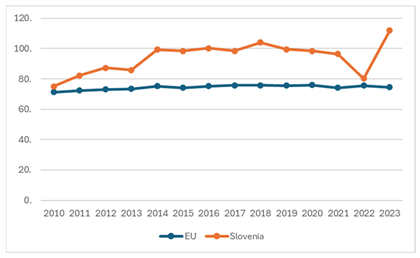 |
Disclaimer/Publisher’s Note: The statements, opinions and data contained in all publications are solely those of the individual author(s) and contributor(s) and not of MDPI and/or the editor(s). MDPI and/or the editor(s) disclaim responsibility for any injury to people or property resulting from any ideas, methods, instructions or products referred to in the content. |
© 2025 by the authors. Licensee MDPI, Basel, Switzerland. This article is an open access article distributed under the terms and conditions of the Creative Commons Attribution (CC BY) license (https://creativecommons.org/licenses/by/4.0/).
Share and Cite
Džajić Uršič, E.; Pandiloska Jurak, A.; Topić Božič, J. From Policy to Practice: EU Circular Economy Legislation and Slovenia’s Implementation Challenges—A Systematic Review. Sustainability 2025, 17, 9408. https://doi.org/10.3390/su17219408
Džajić Uršič E, Pandiloska Jurak A, Topić Božič J. From Policy to Practice: EU Circular Economy Legislation and Slovenia’s Implementation Challenges—A Systematic Review. Sustainability. 2025; 17(21):9408. https://doi.org/10.3390/su17219408
Chicago/Turabian StyleDžajić Uršič, Erika, Alenka Pandiloska Jurak, and Jelena Topić Božič. 2025. "From Policy to Practice: EU Circular Economy Legislation and Slovenia’s Implementation Challenges—A Systematic Review" Sustainability 17, no. 21: 9408. https://doi.org/10.3390/su17219408
APA StyleDžajić Uršič, E., Pandiloska Jurak, A., & Topić Božič, J. (2025). From Policy to Practice: EU Circular Economy Legislation and Slovenia’s Implementation Challenges—A Systematic Review. Sustainability, 17(21), 9408. https://doi.org/10.3390/su17219408






